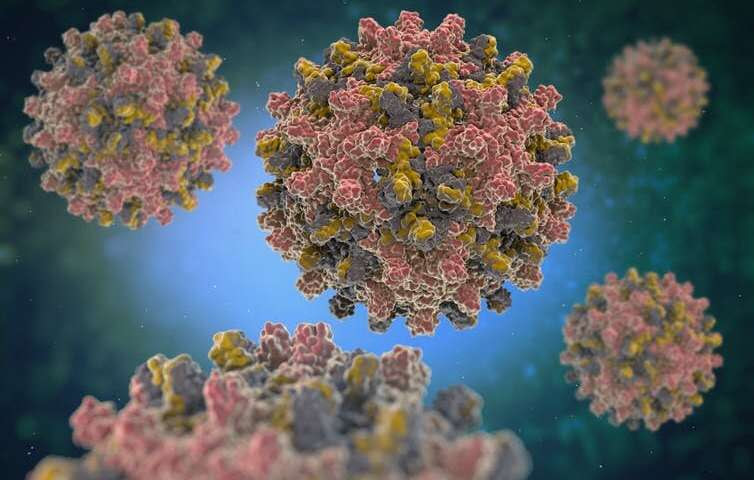by Daniel Brewer, The Conversation
Cervical cancer is one of the only cancers that can be prevented by a vaccine. This is because around 98% of all cervical cancer cases are caused by the human papillomavirus (HPV), which implants DNA in the genome of human cells, causing them to become cancerous.

The HPV vaccine can prevent infection by two of the most common types of this virus, which stops it from causing cancer. The vaccine is routinely given to adolescent girls aged 13 and above in the UK, and has reduced pre-cancerous cervical disease in women by 71% since 2008.
But research also shows than an estimated 20%-40% of human cancers, including cervical, liver, nasopharyngeal and stomach and bladdercancers, are also caused by bacteria and viruses. Knowing more about which bacteria and viruses cause cancer—and the effect they have—could transform treatments for cancer patients, and potentially lead to the development of other cancer-preventing vaccines.
What we found
For the first time ever, our team has shown which viruses are found in the cells of a large variety of cancers. Our team used tissue samples from a large database of 2,600 genomes and 38 different tumor types. The DNA of these tissues from cancer patients had been sequenced, showing both cells and any bacteria or viruses present in the sample.
After analyzing the whole cancer genome, we discovered traces of 23 different virus types in 356 cancer patients. The four most common viruses detected were Epstein-Barr virus, Hepatitis B virus, Human herpesvirus 6B, and HPV. A total of 13% of the samples had evidence of viruses having been present when the sample was taken. We discovered more traces of viruses in more tumors than we’d expected, suggesting that using vaccines to prevent cancer could be a more widespread solution than previously thought.

Not only were we able to confirm which viruses cause tumor growth, we also discovered they were common and present in types of cancer we didn’t expect them to be. We found the genome for Epstein-Barr viruses (a type of herpes virus) in 5.5% of the cancer genomes we investigated. The virus is known to cause lymphoma, stomach, and nasopharyngeal cancers, but we also saw it in other types of cancers such as liver, pancreatic, colon, prostate and skin cancer.
We found Hepatitis B virus DNA in 62 of the 330 cases of liver cancer we investigated. We also found human papillomaviruses – most commonly HPV16 – in 19 of 20 cervical cancers cases, and in 18 of 57 head and neck tumors. Our study found traces of viruses in considerably more tumors than earlier studies had found. Our study’s findings also mean we can rule out a connection between some viruses and cancer—including adenoviruses and baculoviruses, which were previously suspected of causing tumors.
We also learned more about the methods viruses use to encourage cancer cells to grow. For example, in some of the tumors that contained HPV and Epstein-Barr viruses, we found that changes we would normally see in the DNA (which would lead to cancer growth) were actually missing. This leads us to believe that the presence of the virus is providing some of the characteristics needed to drive the cancer itself—such as stopping faulty cells from killing themselves, and encouraging them to multiply rapidly to form tumors.
We also found that the presence of a virus in cervical, bladder or head-and-neck cancer tumors can cause a pattern of changes in the genome that leads to a faulty DNA damage repair mechanism in the human cell. When faults in the DNA aren’t repaired, it causes the tumor to develop more rapidly. Viruses were also found to be duplicating or deleting sections of human cell DNA, leading to cancer.
Another interesting discovery was that if high levels of endogenous retrovirus ERV1 were found in a patient with kidney cancer, it was likely their cancer would progress quicker than a patient who didn’t have the virus present in their kidney cancer cells: approximately 45% of patients with high levels of the virus present died within ten years, compared to around 95% ten-year survival rate for those who didn’t have the virus present. This could help guide the doctor on the best treatment option for the patient. For example, if this virus was detected, a more radical treatment such as chemotherapy with greater side effects might be considered instead of just closely monitoring the tumor with regular diagnostic tests and clinic appointments (active surveillance).
This is the first time that a systematic study of the majority of cancer types caused by viruses has been made. Knowing the links between infections and cancer types could potentially lead to new vaccines like the HPV vaccine, which could reduce the global impact of cancer.

Leave a Reply